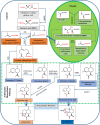The YABBY Family Transcription Factor AaYABBY5 Directly Targets Cytochrome P450 Monooxygenase (CYP71AV1) and Double-Bond Reductase 2 (DBR2) Involved in Artemisinin Biosynthesis in Artemisia Annua
- PMID: 31552076
- PMCID: PMC6746943
- DOI: 10.3389/fpls.2019.01084
The YABBY Family Transcription Factor AaYABBY5 Directly Targets Cytochrome P450 Monooxygenase (CYP71AV1) and Double-Bond Reductase 2 (DBR2) Involved in Artemisinin Biosynthesis in Artemisia Annua
Abstract
Artemisinin is an effective antimalarial sesquiterpene lactone synthesized in Artemisia annua. Various transcription factors have been previously reported that can influence the biosynthesis of artemisinin; however, the effect of YABBY family transcription factors on artemisinin biosynthesis was unknown. In the present study, we cloned and characterized AaYABBY5: a homolog of MsYABBY5 in Mentha spicata which is involved in modulating the monoterpenes, as a positive regulator of artemisinin biosynthesis in A. annua. AaYABBY5 was found localized to the nucleus, and its expression was found to be induced by exogenous methyl jasmonic acid (MeJA) treatment. In the dual-luciferase reporter assay, it was found that AaYABBY5 significantly increased the activities of promoters of amorpha-4,11-diene synthase (ADS), cytochrome P450 monooxygenase (CYP71AV1), double-bond reductase 2 (DBR2), and aldehyde dehydrogenase 1 (ALDH1) genes. Yeast one hybrid assay showed that AaYABBY5 directly bonds to the promoters of CYP71AV1 and DBR2 genes. Quantitative real-time polymerase chain reaction (qPCR) of AaYABBY5 overexpression and AaYABBY5 antisense plants revealed a significant increase in the expression of ADS, CYP71AV1, DBR2, and ALDH1 in AaYABBY5 overexpression plants and a significant decrease in the expression of these genes in AaYABBY5 antisense A. annua, respectively. Furthermore, the results of high-performance liquid chromatography (HPLC) showed that the artemisinin and its precursor dihydroartemisinic acid were significantly increased in the AaYABBY5 overexpression plants while AaYABBY5 downregulation resulted in a significant decrease in the concentration of artemisinin. Taken together, these results explicitly represent that AaYABBY5 is a positive regulator of artemisinin biosynthesis in A. annua.
Keywords: Artemisia annua; CYP71AV1; DBR2; YABBY family transcription factor; artemisinin; sesquiterpene.
Figures








References
LinkOut - more resources
Full Text Sources
Miscellaneous

